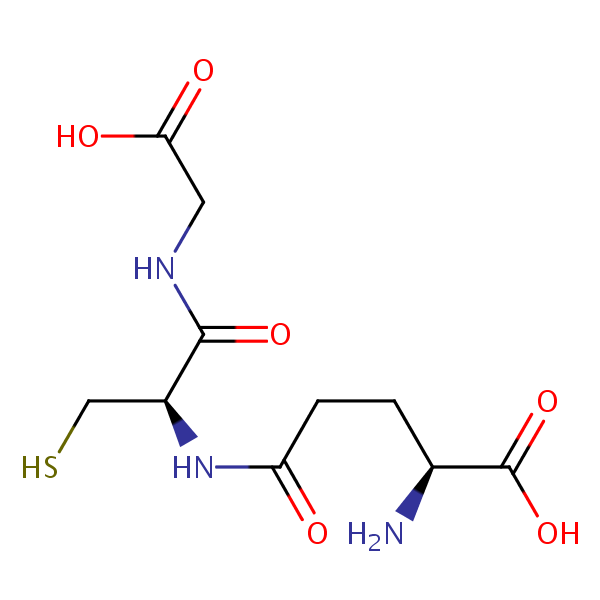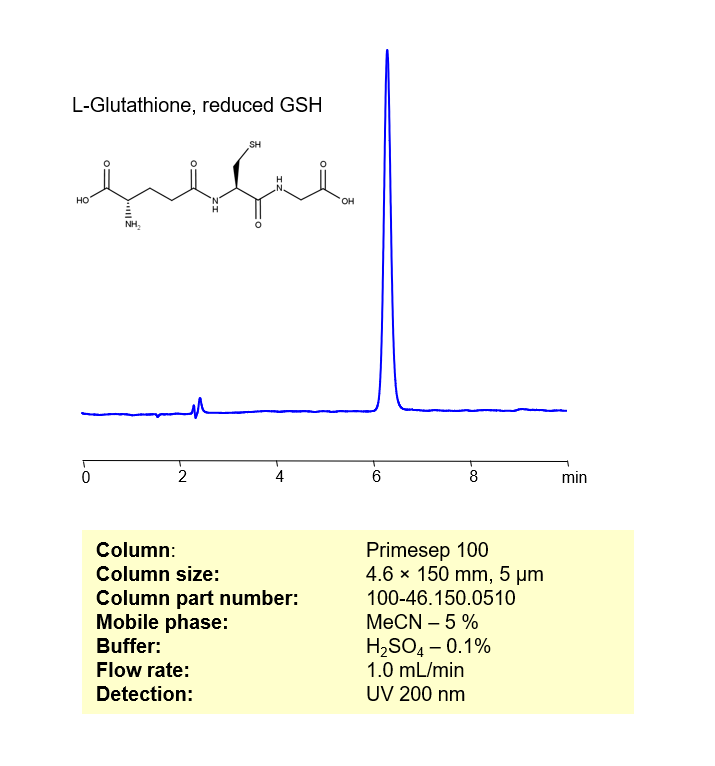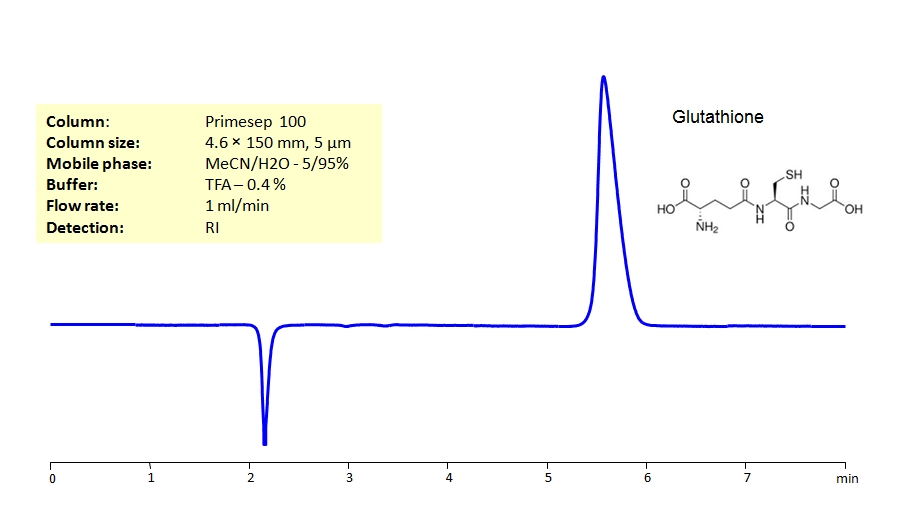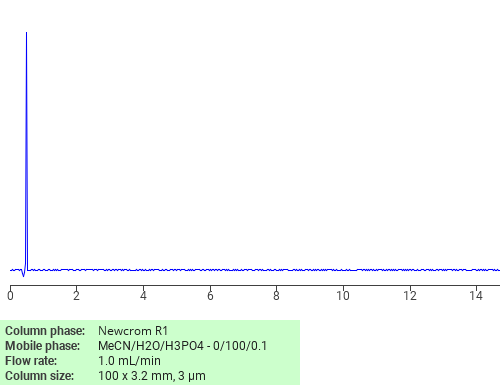| CAS Number | 70-18-8 |
|---|---|
| Molecular Formula | C10H17N3O6S |
| Molecular Weight | 307.321 |
| InChI Key | RWSXRVCMGQZWBV-WDSKDSINSA-N |
| LogP | -2.58 |
| Synonyms |
|
Applications:
UV-Vis Spectrum of Glutathione Reduced
July 11, 2024
UV-Vis Spectrum of Glutathione Reduced. Absorption starts high at 190 nm but quickly falls off and bottoms out around 245 nm.
For optimal results in HPLC analysis, it is recommended to measure absorbance at a wavelength that matches the absorption maximum of the compound(s) being analyzed. The UV spectrum shown can assist in selecting an appropriate wavelength for your analysis. Please note that certain mobile phases and buffers may block wavelengths below 230 nm, rendering absorbance measurement at these wavelengths ineffective. If detection below 230 nm is required, it is recommended to use acetonitrile and water as low UV-transparent mobile phases, with phosphoric acid and its salts, sulfuric acid, and TFA as buffers.

HPLC Method for Analysis of Glutathione reduced (GSH) on Primesep 100 Column
June 14, 2023
HPLC Method for Analysis of Glutathione on Primesep 100 by SIELC Technologies
Separation type: Liquid Chromatography Mixed-mode
L-Glutathione, also known as reduced glutathione or simply GSH, is a tripeptide made up of three amino acids: L-glutamic acid, L-cysteine, and glycine.
Glutathione is found in nearly all cells, and in its reduced form (GSH), it is a powerful antioxidant. It plays a crucial role in protecting cells against oxidative stress by neutralizing reactive oxygen species such as free radicals and peroxides.
The unique aspect of glutathione is the cysteine thiol group (SH) which acts as a reducing agent and can be reversibly oxidized and reduced. In cells, glutathione is maintained in the reduced form by the enzyme glutathione reductase, which reduces the disulfide form of the molecule (GSSG, glutathione disulfide) back to GSH.
Apart from being an antioxidant, glutathione also plays other important roles including detoxification, immune system support, protein function regulation, and as a cofactor for various enzymes. Its deficiency can lead to cellular stress and dysfunction, underscoring its vital role in maintaining cellular health.
In supplement form, L-Glutathione is often used with the intent to support antioxidant activity in the body. However, it is important to consult with a healthcare provider before starting any new supplement regimen.
L-Glutathione retained and analyzed using a reverse-phase Primesep 100, 4.6 x 150 mm, 5 µm, 100 A, dual ended column. The mobile phase for this method consists of water, acetonitrile (MeCN), and sulfuric acid, which serves as a buffer. This analytical method can be monitored using UV detection at 200 nm.
LOD was determined for this combination of instrument, method, and analyte, and it can vary from one laboratory to another even when the same general type of analysis is being performed.
High Performance Liquid Chromatography (HPLC) Method for Analysis of Glutathione
Condition
| Column | Primesep 100, 4.6 x 150 mm, 5 µm, 100 A, dual ended |
| Mobile Phase | MeCN/H2O -5/95% |
| Buffer | H2SO4 – 0.1% |
| Flow Rate | 1.0 ml/min |
| Detection | UV 200 nm |
| Peak Retention Time | 6,12 min |
| Sample concentration | 0.5 mg/ml |
| Injection volume | 1 µl |
| Sample diluent | H2O + NaOH |
| LOD | 50 ppb |
Description
| Class of Compounds | Thiol, Amino acid |
| Analyzing Compounds | Glutathione, reduced (GSH) |
Application Column
Primesep 100
Column Diameter: 4.6 mm
Column Length: 150 mm
Particle Size: 5 µm
Pore Size: 100 A
Column options: dual ended

HPLC Method for Analysis off Glutathione on Primesep 100 Column
March 6, 2020
HPLC Method for Separation of Glutathione on Primesep 100 by SIELC Technologies
High Performance Liquid Chromatography (HPLC) Method for Analysis of Glutathione.
Glutathione is a tripeptide composed of three amino acids: glutamate, cysteine, and glycine. It’s often referred to as the body’s “master antioxidant” because of its vital role in maintaining cellular health and preventing oxidative stress.
Here are some key functions and characteristics of glutathione:
- Antioxidant Function: Glutathione is the most prevalent endogenous antioxidant, protecting cells from damage by neutralizing harmful free radicals and reactive oxygen species. It also regenerates other antioxidants, like vitamins C and E, from their oxidized forms.
- Detoxification: Glutathione contributes to the neutralization of many different types of harmful substances, such as pollutants, heavy metals, and some drugs, thereby aiding in the detoxification process.
- Immune System Support: It plays a crucial role in the proper function of white blood cells, including T cell lymphocytes—the foundation of adaptive immunity.
- Health and Disease: Low levels of glutathione have been linked to several diseases, including cancer, neurodegenerative disorders such as Parkinson’s disease, cardiovascular diseases, and HIV/AIDS. Additionally, glutathione levels typically decrease with age, which can contribute to the aging process.
Glutathione is primarily synthesized in the liver and then distributed to other tissues in the body. It can also be obtained from some foods, especially fruits, vegetables, and meats.
Glutathione can be retained on Primesep 100 mixed-mode column using a mobile phase of Acetonitrile (ACN), water and Trifluoroacetic acid (TFA) buffer. This analysis method can be detected via Refraction Index (RI) Detection, mass spectrometry (MS), evaporative light scattering detection (ELSD) and Charged aerosol detection (CAD).
High Performance Liquid Chromatography (HPLC) Method for Analysis of Glutathione
| Column | Primesep 100, 4.6 x 150 mm, 5 µm, 100 A, dual ended |
| Mobile Phase | MeCN/H2O – 5/95% |
| Buffer | TFA – 0.4% |
| Flow Rate | 1.0 ml/min |
| Detection | RI |
| Class of Compounds | Drug, Acid, Hydrophilic, Ionizable, Vitamin, Supplements, Amino acid |
| Analyzing Compounds | Glutathione |
Application Column
Primesep 100
Column Diameter: 4.6 mm
Column Length: 150 mm
Particle Size: 5 µm
Pore Size: 100 A
Column options: dual ended

Separation of Glutathione on Newcrom R1 HPLC column
February 16, 2018
Glutathione can be analyzed by this reverse phase (RP) HPLC method with simple conditions. The mobile phase contains an acetonitrile (MeCN), water, and phosphoric acid. For Mass-Spec (MS) compatible applications the phosphoric acid needs to be replaced with formic acid. Smaller 3 µm particles columns available for fast UPLC applications. This liquid chromatography method is scalable and can be used for isolation impurities in preparative separation. It also suitable for pharmacokinetics.
Application Column
Newcrom R1
The Newcrom columns are a family of reverse-phase-based columns. Newcrom A, AH, B, and BH are all mixed-mode columns with either positive or negative ion-pairing groups attached to either short (25 Å) or long (100 Å) ligand chains. Newcrom R1 is a special reverse-phase column with low silanol activity.
Select options







